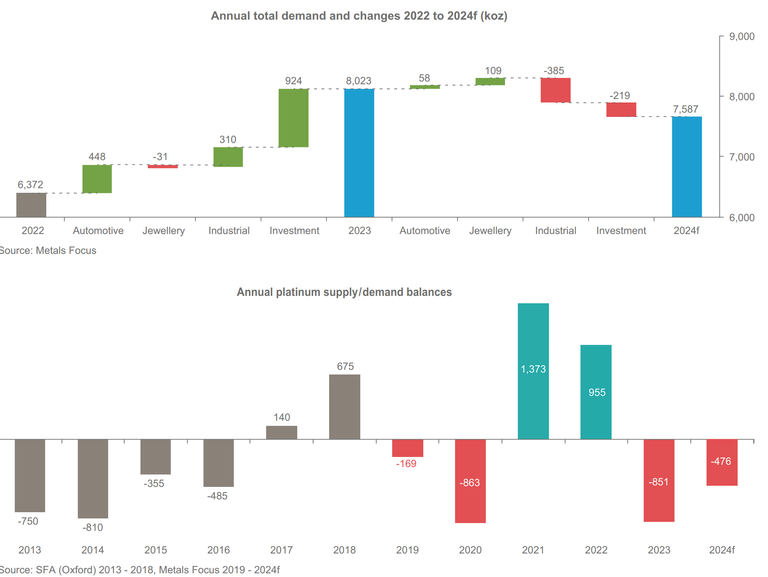SPOT MARKET IS OPEN (WILL CLOSE IN 6 HRS. 25 MINS. )
Live Spot Gold
Bid/Ask
2,341.302,342.30
Low/High
2,337.902,365.20
Change
-18.40-0.78%
30daychg
-1.60-0.07%
1yearchg
+330.80+16.45%
Silver Price & PGMs

Monday, the World Platinum Investment Council released its quarterly supply and demand trend report, announcing that in the first quarter of 2024, the platinum market recorded a deficit of 369,000 ounces; at the same time, the council has revised the annual expected deficit to 476,000 ounces, which follows an 85,000 deficit in 2023.

The increase in the market deficit comes as the council expects to see total demand drop by 5% this year as record industrial demand cools slightly.
In an interview with Kitco News, Edward Sterck, Director of Research at the council, said that while platinum demand is healthy this year, a lack of supply is driving this year’s deficit.
“Platinum supply is forecasted to come to 7.1 million ounces this year, which would be the weakest year for total supply in our time series going back to 2014,” he said.
Sterck added that the total mine supply is expected to drop 3% this year, and while recycling is forecasted to rise 5%, it remains fairly constrained.
“It’s an improvement, but it’s not a big number. We’re still running around, around 15% below long-run levels.”
Supply is driving the market, but don’t ignore demand
Although mine supply will be the most significant factor for platinum this year, Sterk said investors shouldn’t disregard the fact that demand will remain robust, with renewed interest in Jewelry consumption.
In a surprising statistic, the WPIC said that global platinum jewelry demand rose by 5% to 486,000 in the first quarter of this year, supported by a substantial increase in India and growth across most regions except China.
“Indian platinum jewelry fabrication saw a substantial jump of 53% to 59 koz, fuelled by a nine-fold increase in exports to the US and UAE, more men’s jewelry promotion, and new store openings,” the report said.
“It’s the first year in our time series, excluding the post-COVID 2021 recovery, that we’re actually expecting some upside in jewelry,” said Sterk.
Sterk explained that jewelry demand has picked up as the Platinum Guild International has generated renewed interest after launching a new marketing campaign in India and parts of the Middle East.
While jewelry demand is expected to pick up this year, the WPIC forecasts industrial demand, which drove last year’s deficit, to decline. The analysis said that total industrial demand is expected to fall 15% this year due to fewer plant commissionings in the chemicals and glass subsectors.
However, the report noted that industrial platinum fabrication is still 17% above the pre-COVID average.
“Industrial demand can be quite lumpy because it depends upon when you build new facilities; for the most part, we continue to see overall steady growth,” said Sterk. “There’s potential for demand surprises probably to the upside of glass depending on what happens in the wind industry.”
Wind turbines blades are made with fiberglass, which contains platinum alloys.
One solid area of growth within the industrial platinum market is the green hydrogen economy. This is the first report where the WPIC has specifically separated hydrogen demand from the broader category.
The report said the hydrogen market is expected to consume 75,000 ounces of platinum this year, a 128% year-on-year increase. The WPIC expects that by 2030, the hydrogen market will need close to a million ounces of platinum each year.
“The analogy would probably be the impact of photovoltaics has had on silver demand,” said Sterk. “We’ve gone, in two years, from $50 billion worth of government subsidies to over $300 billion; real money is coming into the market.”
While industrial demand is expected to remain solid, platinum’s key market remains the automotive sector. The WPIC said that automotive demand for platin rose to 832,000 ounces in the first quarter, hitting a seven-year high.
Platinum is a critical metal used in automotive catalytic converters to remove harmful emissions from gasoline and diesel engines. Roughly 80% of platinum demand comes from the auto sector.
The report said that for the year, automotive demand is expected to grow by 2% to 3.269 million ounces.
Sterk said that investors are starting to pay attention to platinum as it becomes unlikely that electric vehicles will completely replace traditional internal combustion engines anytime soon.
“Investors are paying more attention to platinum because coming back they’re suddenly realizing that actually maybe we’re not going to be driving Teslas by 2030,” he said.
Sterk added that consumers are embracing hybrid models instead of fully electric vehicles, which use more platinum because the engines run at cooler temperatures.
Although steady industrial demand is attracting some investor attention, Sterk said that demand remains muted.
The WPIC said that global bar and coin investment dropped to 64,000 in the first quarter due to sharp year-on-year declines in Japan and North America, which offset gains in Europe and China.
However, the council expects investment demand to remain positive for the second consecutive year, growing to 99,000 ounces.
“In North America, bar and coin demand remains above pre-pandemic levels and is expected to continue to do so for the full year. China’s retail investment in platinum is forecast to exhibit double-digit growth to 60 koz, driven by perceptions of the metal being undervalued relative to gold. European investment will likely stay flat due to high interest rates,” the analysts said. “Meanwhile, platinum ETF holdings are projected to decrease by 120 koz to 2,946 koz, as high interest rates continue to discourage investment in non-yielding assets.”
Posted by:
Jack Dempsey, President
401 Gold Consultants LLC
jdemp2003@gmail.com

